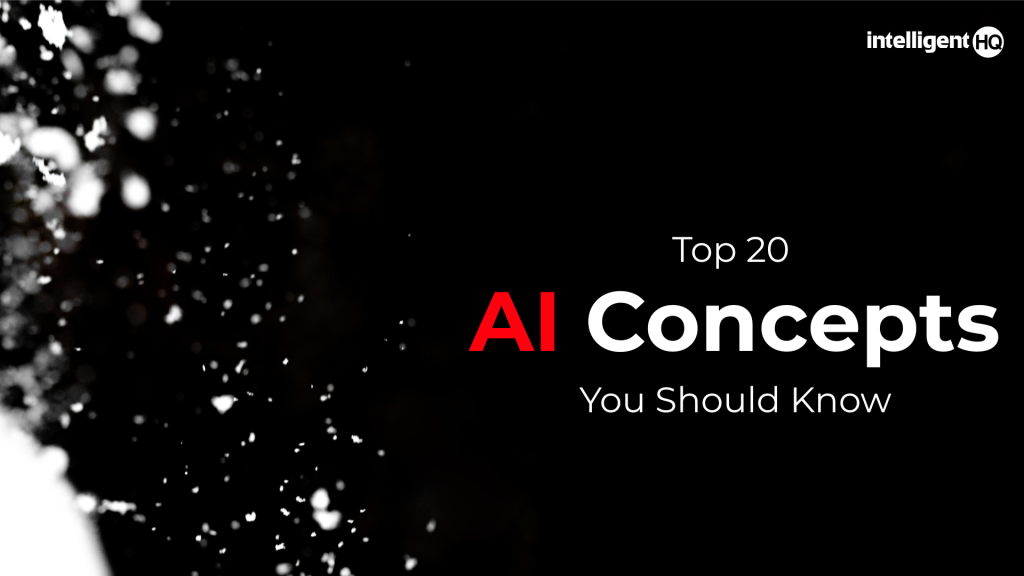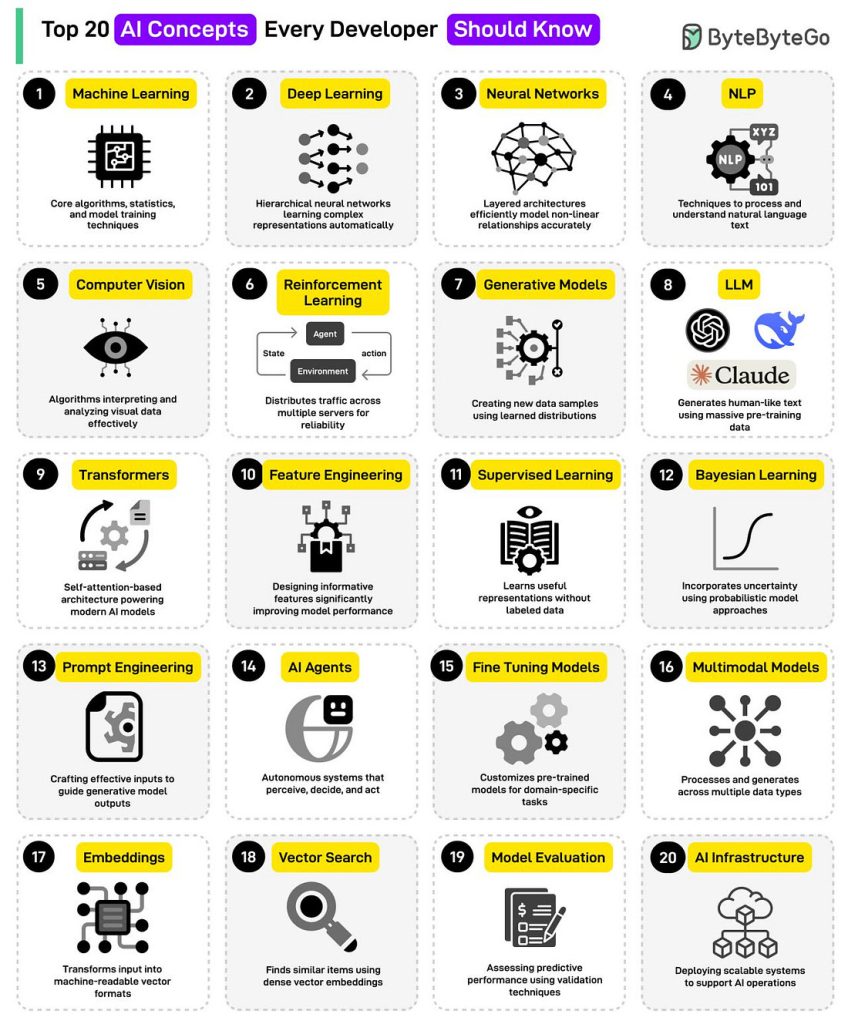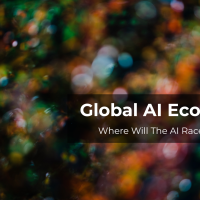You might already be using AI every day, think about Siri, Google Assistant, or those recommendation systems on Netflix that seem to know exactly what you want to watch. Artificial Intelligence (AI) is all around us, shaping everything from the way we work to how we live our lives. Would you like to know more about what powers this technology, and what limits its potentials to revolutionise our lives altogether? Here are some excerpts from an episode of ByteByteGo.

AI is more than just smart assistants and suggestions; it’s a whole field packed with exciting concepts that power everything from self-driving cars to healthcare innovations.
The global AI market is projected to reach a staggering $190 billion by 2025, with industries like healthcare, finance, and automotive increasingly adopting AI technologies.
In fact, a report from McKinsey reveals that AI has the potential to create up to $13 trillion in economic value by 2030.
With such rapid growth and impact, understanding the key AI concepts is more important than ever. Whether it’s Machine Learning powering recommendation systems or Deep Learning enabling facial recognition, these concepts shape the future of technology.
In the episode EP167 of ByteByteGo, they explore the essential AI concepts that everyone should know.
Why Should You Understand These AI Concepts?
The world of AI is constantly evolving, and it’s easy to get lost in the jargon. However, getting a solid grip on the core concepts is important for anyone who wants to get involved in AI, whether you’re an aspiring AI developer, a business professional, or simply a tech enthusiast. These concepts are the building blocks behind every AI breakthrough, and understanding them will give you a deeper appreciation of what’s going on behind the scenes.
Not only will these concepts help you understand how AI works, but they’ll also keep you ahead of the curve as AI continues to impact more industries and even our everyday lives.
AI isn’t just for computer scientists anymore. It’s everywhere:
- Businesses use AI to predict sales, automate customer service, and detect fraud.
- Healthcare relies on AI for faster diagnoses and personalised treatment plans.
- Entertainment platforms like Spotify and YouTube use AI to recommend your next favourite song or video.
- Everyday apps, from Google Maps to Grammarly, are powered by AI.
Top 20 AI concepts

1. Machine Learning
Machine Learning (ML) is at the core of AI. It involves algorithms that allow computers to learn from data without explicit programming. ML is used in various applications, such as predicting trends, classifying data, and detecting anomalies. Key techniques in machine learning include supervised learning, unsupervised learning, and reinforcement learning, which help machines make decisions based on patterns in the data.
2. Deep Learning
Deep Learning is a subset of machine learning that uses neural networks with many layers to model complex patterns in large datasets. These networks can automatically extract high-level features from raw data, making deep learning highly effective in tasks such as image recognition, speech processing, and natural language understanding.
3. Neural Networks
Neural networks are computational models inspired by the human brain, designed to recognise patterns. They consist of layers of interconnected “neurons” that process data. Neural networks are the foundation for deep learning and are capable of modelling highly nonlinear relationships between input and output data.
4. Natural Language Processing (NLP)
Natural Language Processing (NLP) is a branch of AI that focuses on enabling machines to understand, interpret, and generate human language. NLP is crucial in applications such as chatbots, translation services, and sentiment analysis, helping computers process and understand text or speech data.
5. Computer Vision
Computer Vision enables machines to interpret and analyse visual data. By processing images and video, computer vision systems can detect objects, recognise faces, and even understand scenes. This technology is used in autonomous vehicles, medical imaging, and security systems.
6. Reinforcement Learning
Reinforcement Learning (RL) is a type of machine learning where an agent learns by interacting with its environment and receiving feedback in the form of rewards or penalties. RL is used in applications like game playing, robotics, and autonomous vehicles, where the system learns to make decisions by trial and error.
7. Generative Models
Generative models are algorithms that create new data samples by learning from existing data. These models can generate realistic images, text, or even music by capturing the underlying distribution of the data. Generative Adversarial Networks (GANs) are a popular example of this concept.
8. Large Language Models (LLMs)
Large Language Models (LLMs) are sophisticated neural networks trained on vast amounts of textual data. They can generate human-like text, answer questions, and perform complex language tasks. LLMs, like OpenAI’s GPT models, have revolutionised applications such as chatbots, content generation, and language translation.
9. Transformers
Transformers are a type of neural network architecture that has become the foundation for many state-of-the-art AI models, especially in natural language processing. They use a self-attention mechanism to process input data in parallel, significantly improving efficiency and performance in tasks such as machine translation and text generation.
10. Feature Engineering
Feature engineering involves the process of selecting, modifying, or creating new features from raw data to improve the performance of machine learning models. Good feature engineering can significantly enhance the predictive power of models, making it a crucial aspect of building successful AI applications.
11. Supervised Learning
Supervised Learning is a type of machine learning where the model is trained on a labelled dataset. Each training example is paired with a correct output, and the model learns to map inputs to the correct output. This approach is commonly used in classification and regression tasks, such as spam detection or house price prediction.
12. Bayesian Learning
Bayesian Learning is a statistical approach to machine learning that incorporates uncertainty into the model. By using Bayes’ theorem, this method updates the probability of a hypothesis as more data becomes available. Bayesian methods are particularly useful in scenarios where data is incomplete or noisy.
13. Prompt Engineering
Prompt engineering is the practice of crafting input queries in a way that helps guide generative models, such as language models, to produce the desired output. By understanding how models interpret input, prompt engineering can optimise the effectiveness of AI-generated responses.
14. AI Agents
AI agents are autonomous systems that can perceive their environment, make decisions, and take actions based on those decisions. These agents are commonly used in applications such as robotics, virtual assistants, and self-driving cars, where they need to interact with dynamic environments.
15. Fine-Tuning Models
Fine-tuning is the process of adjusting a pre-trained AI model to specialise in a specific task or domain. By applying transfer learning, a model trained on a general dataset can be fine-tuned to improve performance on a specific problem, such as medical image classification or customer service.
16. Multimodal Models
Multimodal models are AI systems that can process and generate across different types of data, such as text, images, and video. These models integrate information from multiple sources to enhance understanding and make more informed decisions. For example, a multimodal model might generate captions for images or analyse videos with both audio and visual cues.
17. Embeddings
Embeddings are a type of representation where input data is transformed into machine-readable vector formats. These vectors capture the semantic meaning of the data, allowing machines to compare and analyse different data points effectively. Embeddings are widely used in NLP and computer vision applications.
18. Vector Search
Vector search is a technique used to find similar items based on dense vector embeddings. By converting data into vectors, AI systems can quickly compare and retrieve items that are most similar to a given query. This technique is commonly used in search engines and recommendation systems.
19. Model Evaluation
Model evaluation is the process of assessing the performance of an AI model using various validation techniques. Common evaluation metrics include accuracy, precision, recall, and F1 score. This step is essential for ensuring that the model generalises well to new data and performs effectively in real-world applications.
20. AI Infrastructure
AI infrastructure refers to the hardware and software systems required to support the deployment, training, and scaling of AI models. This includes powerful computing resources, cloud platforms, and tools for managing AI workflows. As AI grows in complexity, robust infrastructure is essential for handling large datasets and computationally intensive tasks.
About ByteByteGo
ByteByteGo is an online platform dedicated to simplifying complex technical concepts, particularly in system design and software engineering. Founded by Alex Xu, a renowned author of the best-selling book series System Design Interview, An Insider’s Guide, ByteByteGo offers a comprehensive text-based course enriched with detailed illustrations.
This course is designed to guide learners through the intricacies of building scalable and reliable systems, making it an invaluable resource for both aspiring and experienced software engineers.
ByteByteGo also provides a wealth of free content through its newsletter and YouTube channel. These resources delve into various topics such as cloud computing, microservices, and API design, offering practical insights and real-world case studies.

Pallavi Singal is the Vice President of Content at ztudium, where she leads innovative content strategies and oversees the development of high-impact editorial initiatives. With a strong background in digital media and a passion for storytelling, Pallavi plays a pivotal role in scaling the content operations for ztudium’s platforms, including Businessabc, Citiesabc, and IntelligentHQ, Wisdomia.ai, MStores, and many others. Her expertise spans content creation, SEO, and digital marketing, driving engagement and growth across multiple channels. Pallavi’s work is characterised by a keen insight into emerging trends in business, technologies like AI, blockchain, metaverse and others, and society, making her a trusted voice in the industry.









